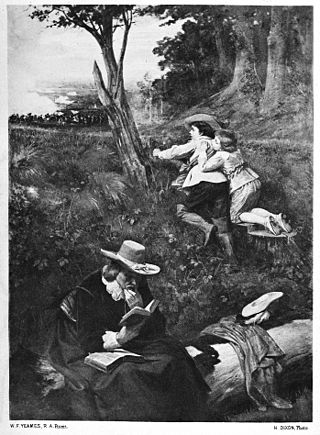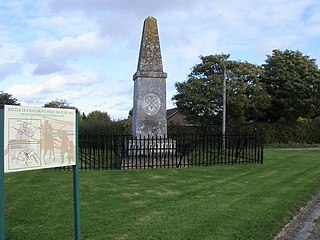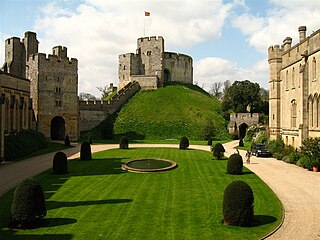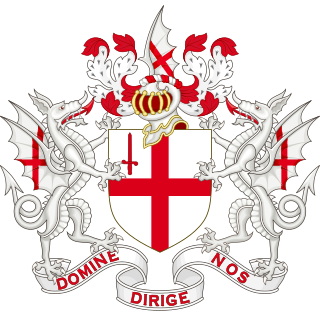The Battle of Lostwithiel took place over a 13-day period from 21 August to 2 September 1644, around the town of Lostwithiel and along the River Fowey valley in Cornwall during the First English Civil War. A Royalist army led by Charles I of England defeated a Parliamentarian force commanded by the Earl of Essex.

The Battle of Naseby took place on 14 June 1645 during the First English Civil War, near the village of Naseby in Northamptonshire. The Parliamentarian New Model Army, commanded by Sir Thomas Fairfax and Oliver Cromwell, destroyed the main Royalist army under Charles I and Prince Rupert. The defeat ended any real hope of royalist victory, although Charles did not finally surrender until May 1646.

The Battle of Edgehill was a pitched battle of the First English Civil War. It was fought near Edge Hill and Kineton in southern Warwickshire on Sunday, 23 October 1642.

Sir William Waller JP was an English soldier and politician, who commanded Parliamentarian armies during the First English Civil War. Elected MP for Andover to the Long Parliament in 1640, Waller relinquished his military positions under the Self-denying Ordinance in 1645. Although deeply religious and a devout Puritan, he belonged to the moderate Presbyterian faction, who opposed the involvement of the New Model Army in politics post 1646. As a result, he was one of the Eleven Members excluded by the army in July 1647, then again by Pride's Purge in December 1648 for refusing to support the Trial of Charles I, and his subsequent execution in January 1649.

Jacob Astley, 1st Baron Astley of Reading was a Royalist commander in the English Civil War and most famously served during the Battle of Newbury and Naseby. He also was involved in the Dutch Revolt and the Thirty Years War. After the second phase of the Civil War, he was imprisoned and then retired in Maidstone. He died shortly after in 1652.

The First English Civil War took place in England and Wales from 1642 to 1646, and forms part of the 1639 to 1653 Wars of the Three Kingdoms. An estimated 15% to 20% of adult males in England and Wales served in the military at some point between 1639 and 1653, while around 4% of the total population died from war-related causes. These figures illustrate the widespread impact of the conflict on society, and the bitterness it engendered as a result.

The First Battle of Newbury was a battle of the First English Civil War that was fought on 20 September 1643 between a Royalist army, under the personal command of King Charles, and a Parliamentarian force led by the Earl of Essex. Following a year of Royalist battlefield successes, in which they took Banbury, Oxford and Reading without conflict before storming Bristol, the Parliamentarians were left without an effective army in the west of England. When Charles laid siege to Gloucester, Parliament was forced to muster a force under Essex with which to beat Charles' forces off. After a long march, Essex surprised the Royalists and forced them away from Gloucester before beginning a retreat to London. Charles rallied his forces and pursued Essex, overtaking the Parliamentarian army at Newbury and forcing them to march past the Royalist force to continue their retreat.

The Second Battle of Newbury was a battle of the First English Civil War fought on 27 October 1644, in Speen, adjoining Newbury in Berkshire. The battle was fought close to the site of the First Battle of Newbury, which took place in late September the previous year.

The battle of Powick Bridge was a skirmish fought on 23 September 1642 south of Worcester, England, during the First English Civil War. It was the first engagement between elements of the principal field armies of the Royalists and Parliamentarians. Sir John Byron was escorting a Royalist convoy of valuables from Oxford to King Charles's army in Shrewsbury and, worried about the proximity of the Parliamentarians, took refuge in Worcester on 16 September to await reinforcements. The Royalists despatched a force commanded by Prince Rupert. Meanwhile, the Parliamentarians sent a detachment, under Colonel John Brown, to try to capture the convoy. Each force consisted of around 1,000 mounted troops, a mix of cavalry and dragoons.

The Battle of Chalgrove Field took place on 18 June 1643, during the First English Civil War, near Chalgrove, Oxfordshire. It is now best remembered for the death of John Hampden, who was wounded in the shoulder during the battle and died six days later.
The Eastern Association of counties was an administrative organisation set up by Parliament in the early years of the First English Civil War. Its main function was to finance and support an army which became a mainstay of the Parliamentarian military effort until early 1645. In January 1644 committeemen of the Eastern Association gathered at the Bury Conference to discuss their concerns as regards the proposed New Model Army. However in the following months many of its units were incorporated into this new military formation.
The siege of Gloucester took place between 10 August and 5 September 1643 during the First English Civil War. It was part of a Royalist campaign led by King Charles I to take control of the Severn Valley from the Parliamentarians. Following the costly storming of Bristol on 26 July, Charles invested Gloucester in the hope that a show of force would prompt it to surrender quickly and without bloodshed. When the city, under the governorship of Lieutenant-Colonel Edward Massey, refused, the Royalists attempted to bombard it into submission. Massey adopted an aggressive defence, and the Royalist positions outside the city were regularly disrupted by Parliamentarian raids. The Royalist artillery proved inadequate for the task of siege work and, faced with a shortage of ammunition, the besiegers attempted to breach the city walls by mining. With Royalist miners about to reach the city's east gate and the defenders critically low on gunpowder, a Parliamentarian army led by the Earl of Essex arrived and forced Charles to lift the siege.

Crockham Heath is a hamlet in Berkshire, England. Crockham Heath is part of the civil parish of Enborne. The settlement lies near to the A34 road, and is located approximately 3 miles (4.8 km) south-west of Newbury.

The Storming of Bristol took place from 23 to 26 July 1643, during the First English Civil War. The Royalist army under Prince Rupert captured the important port of Bristol from its weakened Parliamentarian garrison. The city remained under Royalist control until the second siege of Bristol in September 1645.
The First English Civil War started in 1642. By the end of the year neither side had succeeded in gaining an advantage, although the King's advance on London was the closest Royalist forces came to threatening the city.
1643 was the second year of the First English Civil War. Politically, the latter months of the year were the turning-point of the war. The King made a truce with the Irish rebels on 15 September which united against him nearly every class in Protestant England. Only ten days after the "Irish Cessation," Parliament at Westminster swore to the Solemn League and Covenant, and the die was cast.
1644 was the third year of the First English Civil War. The King's position continued to decline and the Long Parliament sent the Propositions of Uxbridge, an attempt to end the war, to the king at Oxford

The siege of Arundel took place during the First English Civil War, from 19 December 1643 to 6 January 1644, when a Royalist garrison surrendered to a Parliamentarian army under Sir William Waller.

The Battle of Bramber Bridge was a minor skirmish that took place on 13 December 1643, during the First English Civil War. A Royalist detachment from Arundel attempted to secure the bridge over the River Adur at Bramber in West Sussex, but found a Parliamentarian force already in possession.

The London Trained Bands (LTBs) were a part-time military force in the City of London from 1559 until they were reconstituted as conventional Militia regiments in 1794. They were periodically embodied for home defence, for example in the army mustered at Tilbury during the Armada Campaign of 1588. They saw a great deal of active service during the English Civil War, including the First and Second Battles of Newbury, and the battles of Alton, Cheriton, Cropredy Bridge and Lostwithiel. Throughout their history they were used to suppress civil disorder and insurrection around the capital.














